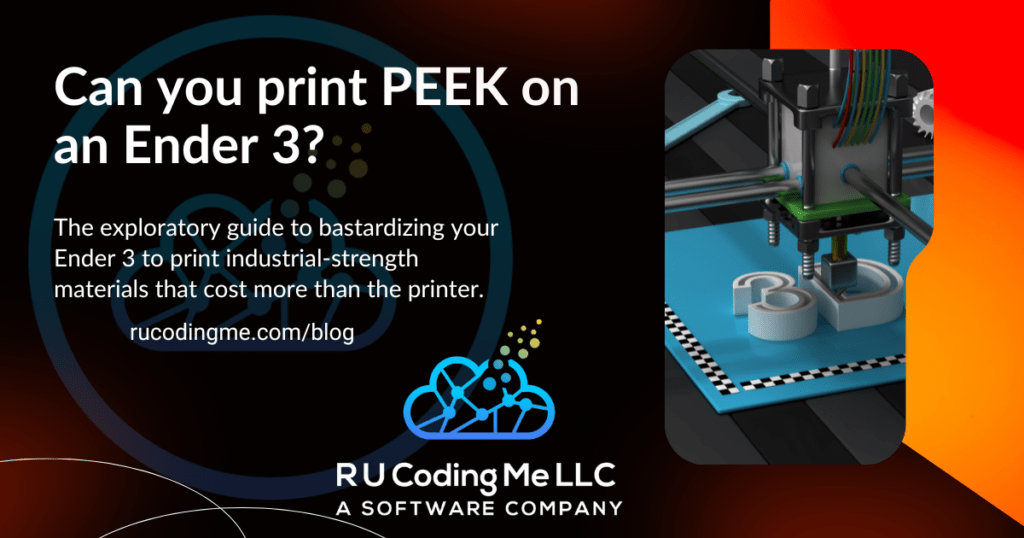Introduction
It’s a question that we hear all the time: Can you print PEEK on an Ender 3? And while it may seem like a simple query, the answer is more complicated than you might expect. In this article, we’ll go over what PEEK is and why it’s used in aerospace, marine, industrial and military manufacturing. We’ll also show you why using your Ender 3 to print with PEEK filament isn’t the best idea —or at least not something you should try unless you have some experience with higher-end printers (like those made by Formlabs).
Nonetheless, we’ll go over the upgrades we’ll make to a fresh Ender 3 once we get the funding. This will includes parts you can buy off the shelf and some custom solutions to help offset the cost.
Amazon Disclosure
R U Coding Me LLC is a participant in the Amazon Services LLC Associates Program, an affiliate advertising program designed to provide a way for websites to earn advertising revenues by advertising and linking to Amazon.com or .ca, .co.uk, etc.
PEEK is a polymer that offers a number of advantages over other plastics used to print prototypes and end products.
PEEK is a polymer that offers a number of advantages over other plastics used to print prototypes and end products. It’s stronger and more durable than certain other materials, including ABS (a common filament used in 3D printing) and PLA (which is derived from corn). This makes PEEK an obvious choice for use in the industry where strength is critical. Another advantage of this material is its resistance to chemicals, acids and alkalis. If you’re familiar with 3D printing—and if you’ve ever had your extruder gunk up on a hot summer day—you know how frustrating it can be when your filament goes bad because of some chemical residue left behind by some previous project or other.
Because it’s so stable under different conditions, PEEK can also be used in applications where extreme temperatures might cause other plastics to fail as well: think about cars or airplanes with parts made from this material that must operate at extremely high temperatures. That said, not everyone will have access to a machine capable of using PEEK filament due its higher price tag compared with ABS or PLA filaments; however those who do should definitely consider using this durable material when creating projects that require extra strength or protection from heat sources such as motors or gearboxes!
PEEK is extremely difficult to print successfully and as such is not recommended for use with the Ender 3.
Printers designed to print PEEK start around $25,000, or in layman’s terms a Honda Civic, and the filament can easily run for $2,000 for carbon-fiber reinforced versions. In essence, printing a benchy with PEEK is the equivalent of wiping yourself with hundred dollar bills after you finish defecating in a golden toilet. Now imagine doing all of this on a stock printer that costs less than $200. While it could potentially be cheaper than buying a PEEK printer, it feels wrong nonetheless. Plus, there will be a lot more troubleshooting to consider along with quality issues that may pop up.
Let’s be clear: The ability (or lack there of) to print PEEK is not a reason for you to avoid buying an Ender 3. The Ender 3 is a very capable printer with a broad scope of applications. You can rig an Ender 3 to work with other exotic materials to expand even further, but PEEK is one of the most advanced industrial materials out there. And we want to print on one of the most basic hobbyist printers. Not to mention, most of us have never seen a roll of PEEK in person either.
It will be a long shot to make this work and it will probably end up costing the a lot of money in addition to the Ender 3. Let’s go over some of the limitations of the Ender 3 and why it may not be a good option for PEEK printing:
The high heat required by PEEK filament could damage your Ender 3.
While the Ender 3 is a great printer, it’s not designed to handle the high temperatures required by PEEK. Printing with PEEK filament requires a super hot bed and an even hotter extruder, with the bed being over 100 Celsius and extruder 400 Celsius respectively. The stock Ender 3 has plastic components in its hot end, making the default maximum temperature around 270.
Additionally, the printer bed is not designed to hold high temperatures over long periods of time. While PLA only needs 50-60 degrees Celsius for optimal performance, PEEK requires 100 Celsius. The stock bed can be set to 100, however, this is hopeful to say the least. Most people report only achieving 70 or 80 degrees before seeing inconsistencies in the temperature variation.
To tie it all together, we need to regulate the surrounding air with a heated enclosure. This does not come stock with an Ender 3 simply because you only need enclosures for materials like ABS, ASA and PC to name a few. Additionally, heating the surrounding area around the Ender 3 could damage the internals, as they were not designed to stay at a constant 90-100 degrees Celsius over a prolonged period of time.
Feeding PEEK into your Ender 3
Given the sensitivity PEEK has to the surrounding area, we will need a way to keep the PEEK dry while we are printing. Filament dryers exist and go up to 50 degrees Celsius, however, PEEK should be stored as hot as possible, given the strict printing requirements.
For improved precision, we should consider using a direct-drive system as opposed to a tube setup. The Ender 3’s stock extrusion system may not be suitable and should be replaced with a direct drive. This will give us improved accuracy in the print while providing more stability in the extrusion of PEEK.
Once we have all of this together, we must also consider the wear on our extruder. PEEK is a high performance material and is abrasive, so you should definitely use a hardened nozzle to print.
Ender 3 may not be the best suited for PEEK printing, but it can be done successfully.
The Ender 3 may not be the best suited for PEEK printing, but it can be done successfully. Theoretically… There are several modifications we’ll need to make in order to get it to work. Below, we’ll outline our shopping list and give an overview of how we can set up an Ender 3 to print PEEK.
What to Buy
What to Build
There are still a couple of issues that the upgrades do not solve. Of course, there is a solution to everything, but let’s face it: you want to print PEEK on a budget. To help offset these costs, we can make some of the custom parts ourselves to save some money for filament without selling a kidney.
As we develop solutions, let’s go over some of the problematic areas that the upgrades don’t cover:
Internal Computers Heat Creep
The motherboard and other related components of the Ender 3 may not be suited to sustain high temperatures for prolonged periods of time. Thus, we’ll need to cut a small hole from the enclosure and run extended cables to separate the Ender 3’s guts from the machine. We should also consider designing an extended module to house these parts. It’s a good thing we have a printer for that!
There are certain parts like stepper motors and fans that we cannot move outside of the enclosure. Experimentation will show us if they can sustain high temperatures for prolonged periods of time before warping or breaking.
Bed Temperature
Even with an upgraded bed, we don’t know how constant the Ender 3’s bed will perform at high temperatures. Additionally, some PEEK materials require up to 150 Celsius which is outside of the upgraded range.
With an upgraded bed, it’ll make holding temperatures easier but getting up to 150 will be a significant challenge. We may need to fabricate a custom solution to get the temperature at 150.
Ambient Temperature
The enclosure will help with the surrounding temperature, but PEEK requires at least 90 degrees ambient, which is pretty hot! Heated enclosures that can get up to this temperature are expensive, so we’ll most likely need to jerry-rig a small space heater into the enclosure. Depending on the size of the heater, we may need to modify or create our own enclosure to fit it all together.
Not to mention, this setup will dramatically increase your power bill and raise the temperature in the room by a few degrees Fahrenheit. Designing an efficient enclosure system will help mitigate these issues, as the hot air will stay where it needs to be and the cold air in your room. Of course, you could print this in a garage or workshop and not have to worry about the AC bill.
Conclusion
So, can you print PEEK on an Ender 3? Stock, no way! With upgrades, maybe. We’re hoping to see full support for this filament on an Ender 3 soon. While it is probably not the best idea to do such a thing, it definitely pushes the envelope (dare I say the limit) for entry level printers and their absolute maximum capabilities to perform with industrial level filaments.
With the market demand increasing for super strong parts, industrial additive manufacturing is a growing field. It would be quite a feat to develop a cheap, entry-level solution that can print PEEK decently. While we are not expecting the best resolution on the mother of all Ender 3s, it would certainly be a game changer for newcomers into the field.
That, and it’s pretty funny to think you’ll spend more money on filament than the actual machine! Let us know what you think in the comments. We’d love to hear how you would go about printing peek on Ender 3 printers.
We’ll update this blog post once we have enough funding to actually try this out!

Founder and CEO of R U Coding Me LLC. Jacob obtained his Bachelor’s of Computer Science at the University of Central Florida. He likes to go to the gym and teach people about technology.


